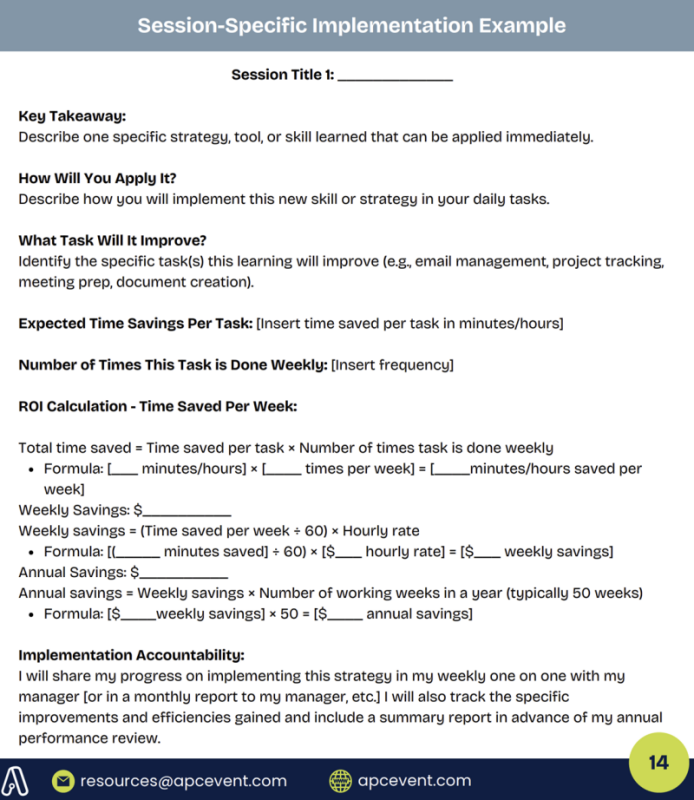Picture this: You built a compelling business case for attending a training conference—and your executive said yes. You’ve returned feeling inspired, equipped with fresh strategies and tools to elevate your role. But, if you want approval for future training, you’ll need to demonstrate the ROI of your last investment and clearly convey its impact to your executive.
The work didn’t stop when you submitted your initial request; that was just the first step. Now, it’s time to track what you’ve implemented, measure the benefits to your organization, and effectively communicate those results.
Here’s how to turn your conference experience into a powerful case for continued professional development:
Create Your Training Implementation Plan
When you return from any training event, the first thing you need to do is create a post-training implementation plan. In this plan, you’ll outline the sessions you attended, the specific things you learned that you plan to implement, the estimated return on investment (ROI) of each item, and how you’ll hold yourself accountable for following through on them and reporting your progress.
Here is the outline of a simple template to help you get started:
-
Title of the training session attended
-
Key takeaways from that training session
-
How you will apply the takeaways
-
What task will it improve
-
Expected time savings per task
-
Number of times this task is done weekly
-
ROI calculation of time saved per week
-
Implementation accountability
After you draft your session-specific implementation plans, then you can summarize the ROI from each session on a cover memo to make presenting the information to your executive more efficient. If applicable, you can expand on this summary by highlighting how you’ll share the things you’ve learned with other team members which increases the benefit to the company.
If you prefer a pre-made version, you can access ASAP’s Training ROI template (shown below) by registering for this webinar, where it is included as a bonus handout.

Presenting Your Post-Conference Implementation Plan to Management
Once you have the implementation plan outlined, it’s time to share it with your executive. This can be done during a weekly one-on-one conversation or by scheduling a brief meeting to specifically discuss it. If you have prepared your implementation plan as outlined above, you can quickly and efficiently present your plan and discuss the highlights in 15-30 minutes. This meeting serves a few purposes:
-
To personally thank your executive again for investing in the training
-
To present your implementation plan and show them that you are serious about making sure their investment in training for you creates return in some form for the company. During this meeting you can also discuss how frequently your executive wants you to report back on the progress you’re making in the weeks and months to come. Depending on the communication style of your executive, you may want to have more specific details ready to share about what you learned from the conference and how you see it benefiting the work you do.
Follow Through and Report Progress
After the meeting, set a reminder in your calendar or task list for when you need to report progress to your executive. Consistent follow-up is key to demonstrating the ongoing value of training investments and increasing the likelihood of gaining approval for future training requests.
As you learn about additional training opportunities you want to present a business case for, review the implementation plan from the past training and calculate the actual ROI achieved so far versus the anticipated ROI. How close were you to your estimates? If you were way over or under in your estimates, what were the contributing factors? Conducting this analysis helps you refine your projections for future requests and strengthens your business case. Being objective and honest with your executive about the process you went through to analyze the outcomes also demonstrates your commitment to ensuring training dollars are well spent.
Strengthening Your Communication and Leadership Skills
This process is more than just proving ROI; it is an opportunity to refine and enhance your communication skills—both written and verbal—while reinforcing your leadership as an administrative professional. By crafting well-structured business cases, articulating your value to executives, and confidently presenting your findings, you establish yourself as a strategic thinker and a proactive contributor to your organization. The ability to translate training investments into measurable results strengthens your credibility and positions you as a leader who not only seeks growth but also ensures that growth benefits the entire organization. Embracing this approach empowers you to advocate for your professional development while demonstrating the impact of continuous learning on business success.


